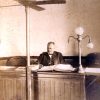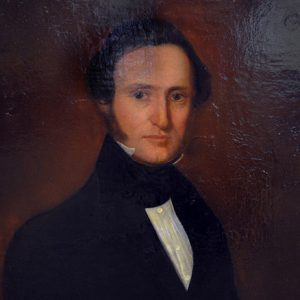calsfoundation@cals.org
State v. Buzzard
State v. Buzzard (1842) was a case in the first half of the nineteenth century involving the right of an individual to carry a concealed weapon. The case came two decades after an 1822 Kentucky case that struck down a state law that restricted concealed weapons—although the weapon at issue there was a sword concealed in a cane. Ultimately, given the facts in Buzzard, coupled with the language of the Second Amendment to the U.S. Constitution, the case has come to be recognized as one of the earliest examinations of the Second Amendment right to bear arms.
The case was heard by the original three members of the Arkansas Supreme Court—Chief Justice Daniel Ringo and Associate Justices Townsend Dickinson and Thomas J. Lacy—and it resulted from an appeal from a November 1839 trial in the Chicot Circuit Court. There, Judge Euclid L. Jonson had quashed the indictment, ruling that the law against the concealed carrying of weapons was unconstitutional. The new state of Arkansas, having been admitted to the union in 1836, appealed, and the Arkansas Supreme Court, by a 2–1 vote, overturned the trial court’s ruling and upheld the law.
Basing its ruling on the “well-regulated militia” provision of the Second Amendment, the court rejected the challenge to the state’s law prohibiting the carrying of a concealed weapon. It asserted that, while the Arkansas constitution guaranteed that “the free white men of the State shall have the right to keep and bear arms for their common defense,” the state still had every right to regulate how arms could be carried. Before coming to his final conclusion, Chief Justice Ringo undertook an extensive examination of the nature of government itself, looking at the basic reasons for its existence as well as the roles and responsibilities it was to fulfill. Concluding that government was intended, among other things, to protect and defend the community in the aggregate, it determined that in order to fulfill that responsibility it was sometimes necessary to regulate individual actions. Distinguishing between political and individual rights, the court looked at other rights and freedoms and noted that they, too, had been subjected to regulation in the best interests of the broader community.
The Court also noted that the Second Amendment contained a provision relating to a well-regulated militia that made clear that the right was not unfettered—or as the Court wrote, the “right…possesses no such immunity as exempts it from all legal regulation and control.” In addition, the court noted that any assertion that a presumed fundamental right to bear arms was being infringed upon was, in fact, not the case, and that the law in question related only to carrying a concealed weapon.
In support of Chief Justice Ringo’s opinion, Justice Dickinson offered a substantive and thoughtful concurrence that reinforced the chief justice’s conclusion, while also noting, among other things, that the law’s focus on concealed weapons differentiated it from the realities of arms that were central to the operation of a well-regulated militia. Justice Lacy, in a dissent, argued that the right to bear arms was based upon an individual right to self-defense. He asserted, “I cannot separate the political freedom of the State from the personal right of its citizens,” adding that “the privilege of the people to keep and bear their private arms for the necessary defense of their person, habitation and property, or for any useful or innocent purpose…has ever been regarded as sacred and inviolable.”
Over the years, the case of State v. Buzzard has become increasingly controversial, and many pro-gun-rights advocates in particular have had trouble with the decision, given the limited, militia-based right that it supports. Indeed, one advocate, attorney Robert Leider, has called it an outlier, asserting that it “had limited precedential value in the nineteenth century,” although that same commentator also acknowledged that “it became the predominant federal court approach beginning in the 1930s.” In a 2009 article in the George Mason Law Review, authors Clayton E. Cramer, Nicholas J. Johnson, and George A. Moscary noted that the decision was regularly cited by courts after the Civil War, but argued that its usage was not because it represented a mainstream view but rather because it was one of the few precedents that supported the postwar laws that imposed some limits on full and unfettered access to guns. Critics notwithstanding, Joel Prentiss Bishop’s influential work Commentaries on the Law of Statutory Crimes, published in 1873 and considered a standard authority in the latter part of the nineteenth century, adopted Buzzard’s militia-based interpretation. While Bishop termed it the “Arkansas Doctrine,” he also offered it as the standard view of the right to bear arms in American law.
Given its interpretation of the Second Amendment right to bear arms as stemming from the well-regulated militia clause, Buzzard remains a touchstone for those who argue that the right is not without limits. However, at the same time, the most recent Supreme Court decisions, including, most prominently, District of Columbia v. Heller (2008), have not pursued that approach. Meanwhile, in a decision that can be traced back to Buzzard, in June 2016 the U.S. Court of Appeals for the Ninth Circuit, basing its ruling on “the overwhelming consensus of historical sources,” determined in Peruta v. County of San Diego that the protections offered by the Second Amendment did not extend to carrying concealed weapons by members of the general public. This allows states to prohibit or restrict the public’s use of concealed weapons.
For additional information:
Levin, John. “The Right to Bear Arms: The Development of the American Experience.” Chicago-Kent Law Review 48 (1971): 148–167.
Lieder, Robert. “Our Non-Originalist Right to Bear Arms.” Indiana Law Journal 89 (Fall 2014): 1587–1651. Online at http://www.repository.law.indiana.edu/cgi/viewcontent.cgi?article=11126&context=ilj (accessed September 15, 2016).
State v. Buzzard, Opinion, Ringo, Ch. J. and Concurrence, Dickinson, J. http://www.constitution.org/2ll/2ndcourt/state/191st.htm (accessed September 15, 2016).
Willis, James F. “Arkansas’s Gun Regulation Laws: Suppressing the ‘Pistol Toter,’ 1838–1925.” Arkansas Historical Quarterly 81 (Summer 2022): 103–126.
William H. Pruden III
Ravenscroft School


 Townsend Dickinson
Townsend Dickinson 



Comments
No comments on this entry yet.